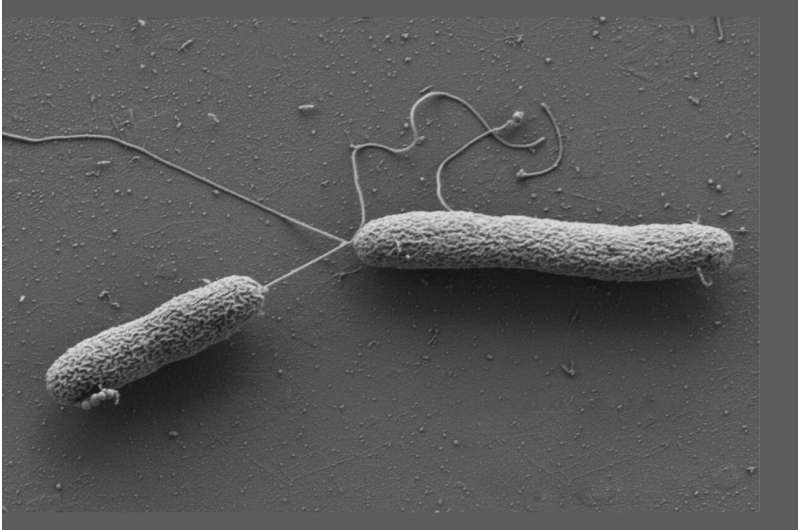How stress hormones guide bacteria in their host

In humans and animals, catecholamines such as epinephrine, norepinephrine, and dopamine are common stress hormones. Stress can increase the body's susceptibility to bacterial infections. In the laboratory, stress hormones stimulate the growth of various pathogens. This had already been observed in Salmonella (Salmonella enterica serovar Typhimurium), and other intestinal bacteria, Escherichia coli and the causative agent of cholera, Vibrio cholerae. Furthermore, epinephrine and norepinephrine make it easier for bacteria to infect the body's cells. And these hormones also influence the biosynthesis of virulence factors, which enable pathogens to adhere to, penetrate, and destroy cells.
"We therefore suspected that some bacteria use such hormones as signals to recognize the eukaryotic host environment," says LMU microbiologist Professor Kirsten Jung. "But the molecular basis was not known." Together with Professor Stephan A. Sieber from the Technical University of Munich (TUM) and other researchers, Jung has now identified the binding site of epinephrine and the epinephrine derivative phenylephrine in the bacterium Vibrio campbellii. As the team reports in PNAS, the target of both molecules is the protein CheW. "The biological significance of the mechanism is that bacteria recognize, for example, that they are no longer in sea water, but in the intestine of a host," explains Jung.
Studies with the model organism V. campbellii
"We wanted to know how bacteria recognize catecholamines as signaling molecules," says the LMU scientist. "Which receptors control this process?" Her experiments consisted of several individual steps.
For the study, Sieber developed a method for chemically modifying epinephrine and phenylephrine, so that the researchers could directly isolate complexes from the catecholamines and the bound bacterial proteins. A prerequisite of the experiments was that the new compounds would not have any biological characteristics that the unmodified molecules did not have. Jung's group did laboratory experiments to demonstrate this was so. Epinephrine binds iron, whereas the epinephrine derivative phenylephrine does not. With their choice of compounds, the researchers wanted to rule out effects that arise when the bacteria have a better supply of iron.
Jung and Sieber worked with Vibrio campbellii as a model organism. The marine bacterium infects fish, shrimp, squid, and many other marine invertebrates. They added Vibrio campbellii to the chemically modified catecholamines and lysed the cells. Next, they extracted from the lysate all proteins to which a molecule had bound and characterized them by using proteome analysis. This resulted in a particular enrichment of the soluble chemotaxis protein CheW.
Subsequently, Jung's group isolated the CheW protein directly from bacteria, purified it, and measured its binding affinity to catecholamines. In the process, the researchers discovered something surprising: the hormones do not bind to the chemoreceptors themselves, as originally expected, but to the coupling protein CheW, which is located between receptors and a signal transduction cascade. This entire stimulus perception system controls the motion of the bacterium in a chemical gradient.
"Our study provides new insights into the communication of bacteria with their host," summarizes Jung. "We were able to show that the swimming behavior of bacteria is modified by host hormones, which is controlled by CheW." Motility, and in particular directed motility, is decisively important for host colonization, as bacteria deliberately seek to colonize an organism and conquer all niches. In the next step, Jung now wants to find out whether the same mechanism can be detected in other bacteria.
More information: Angela Weigert Muñoz et al, Eukaryotic catecholamine hormones influence the chemotactic control of Vibrio campbellii by binding to the coupling protein CheW, Proceedings of the National Academy of Sciences (2022). DOI: 10.1073/pnas.2118227119
Journal information: Proceedings of the National Academy of Sciences
Provided by Ludwig Maximilian University of Munich



















